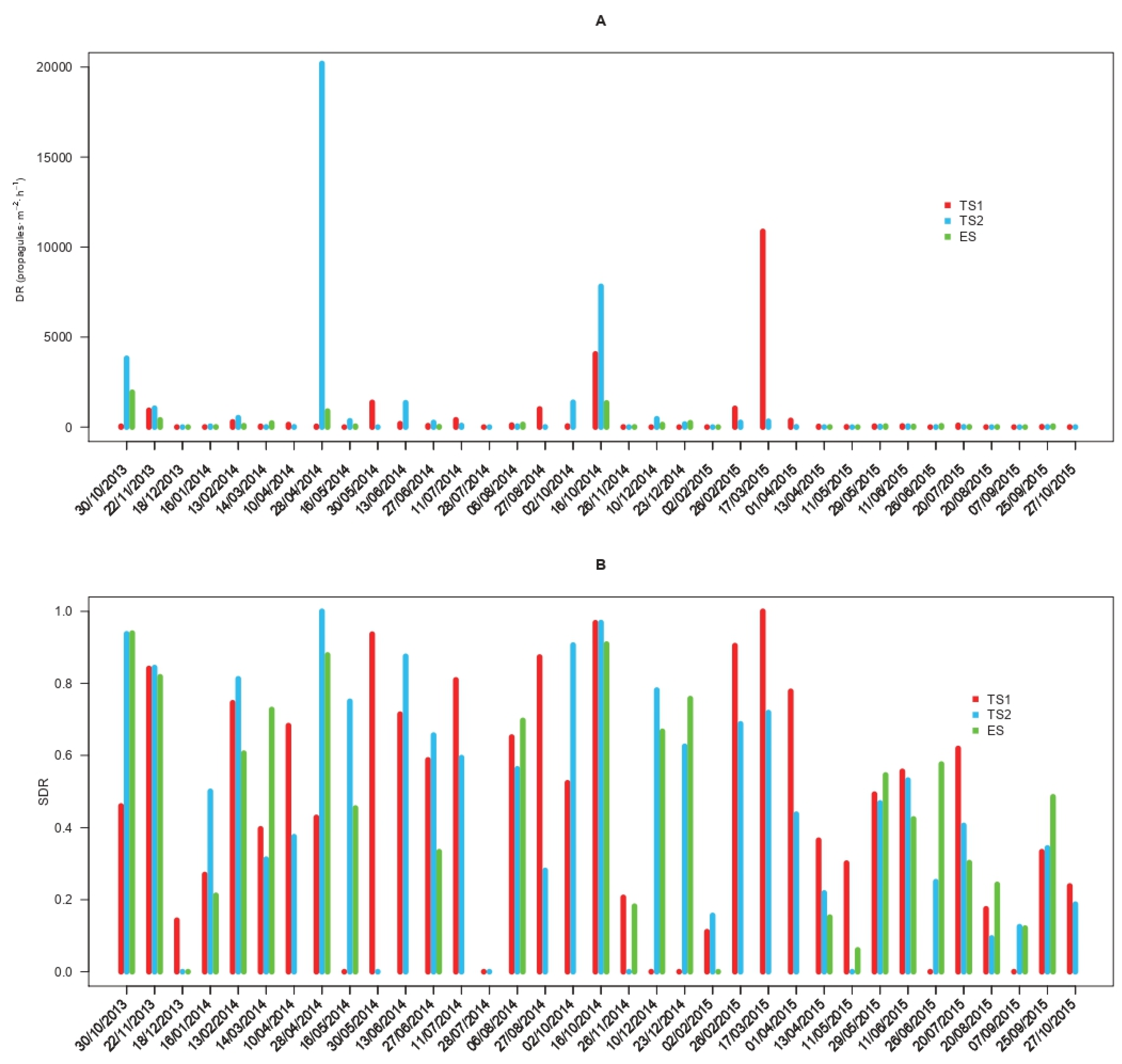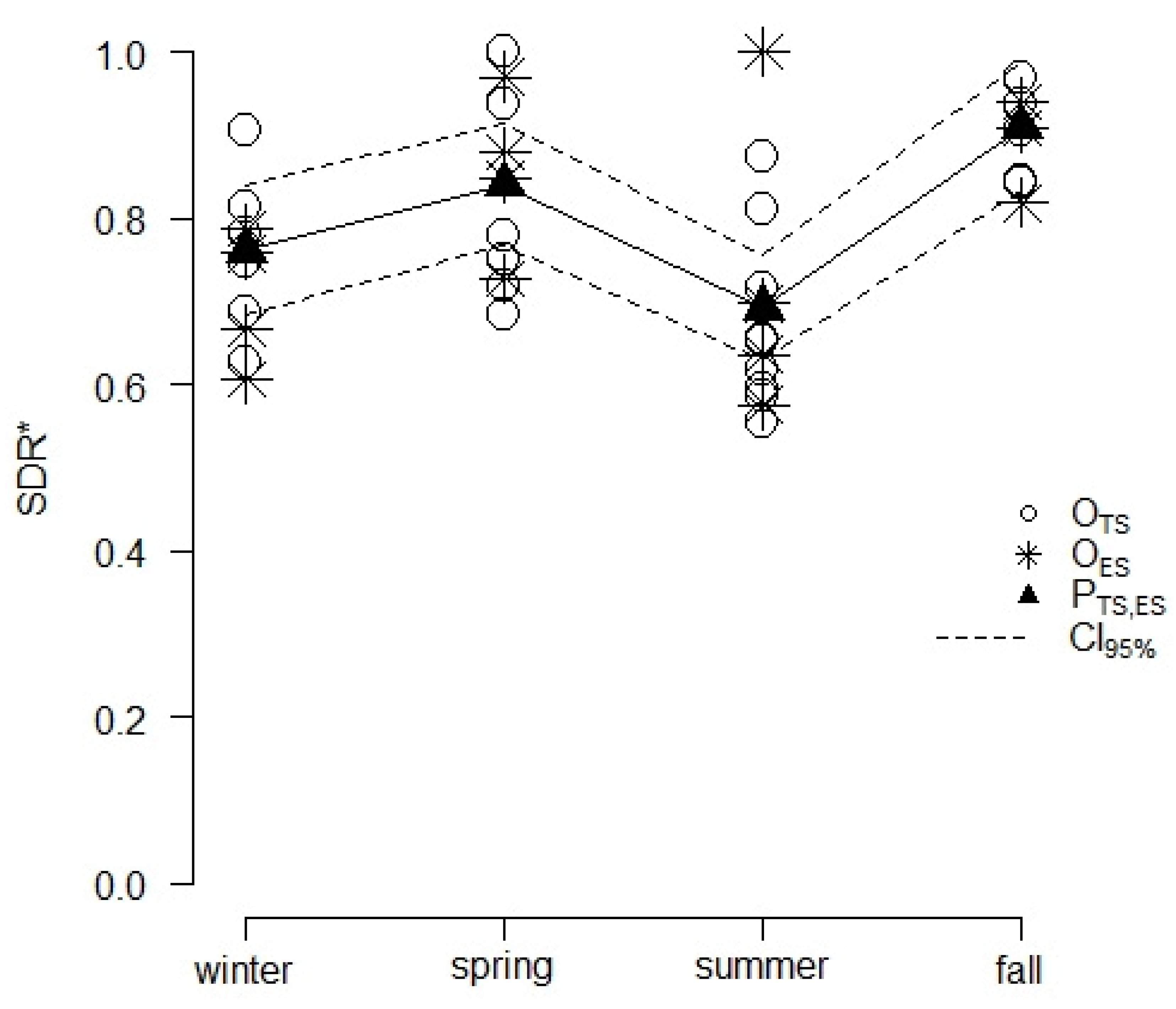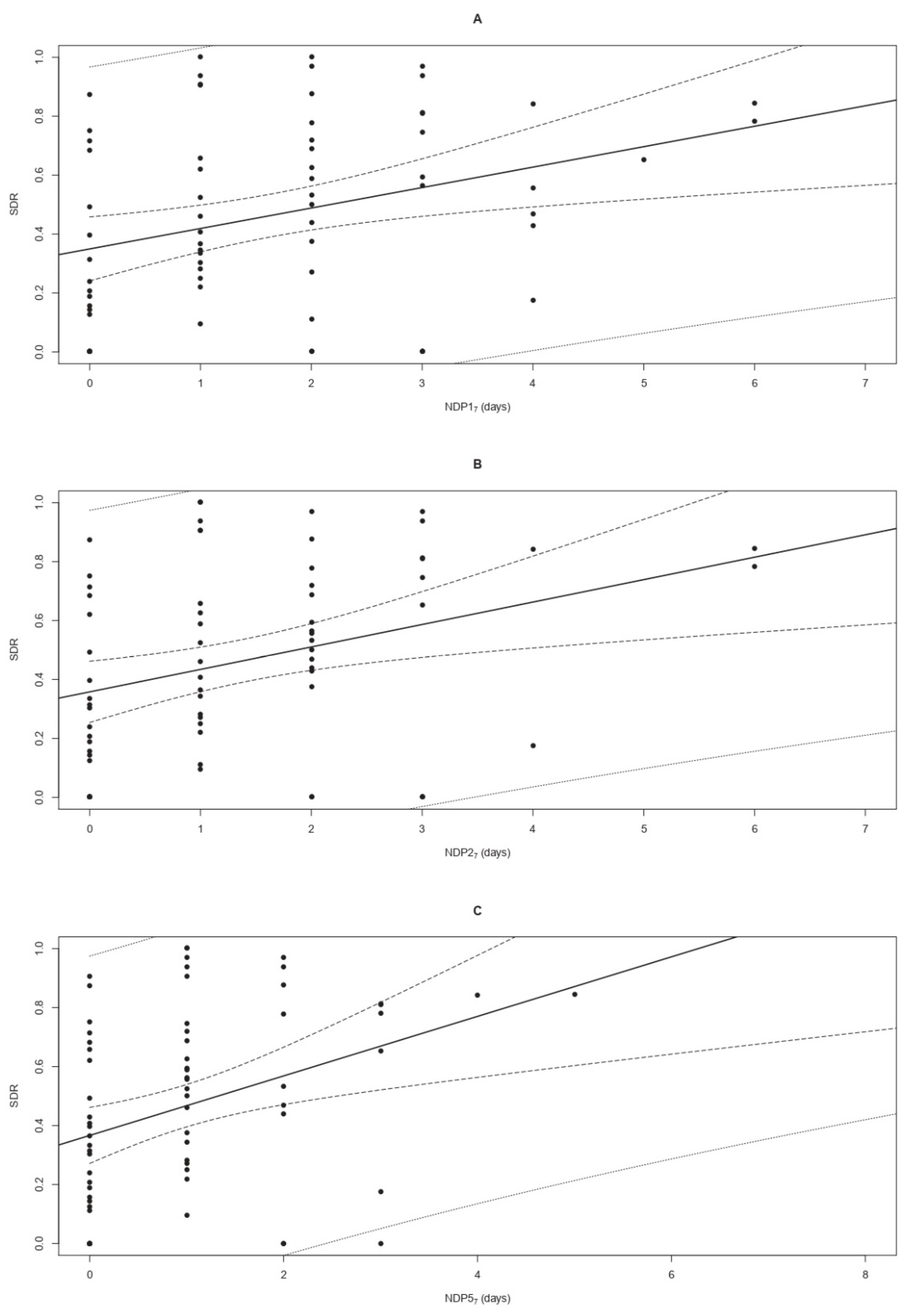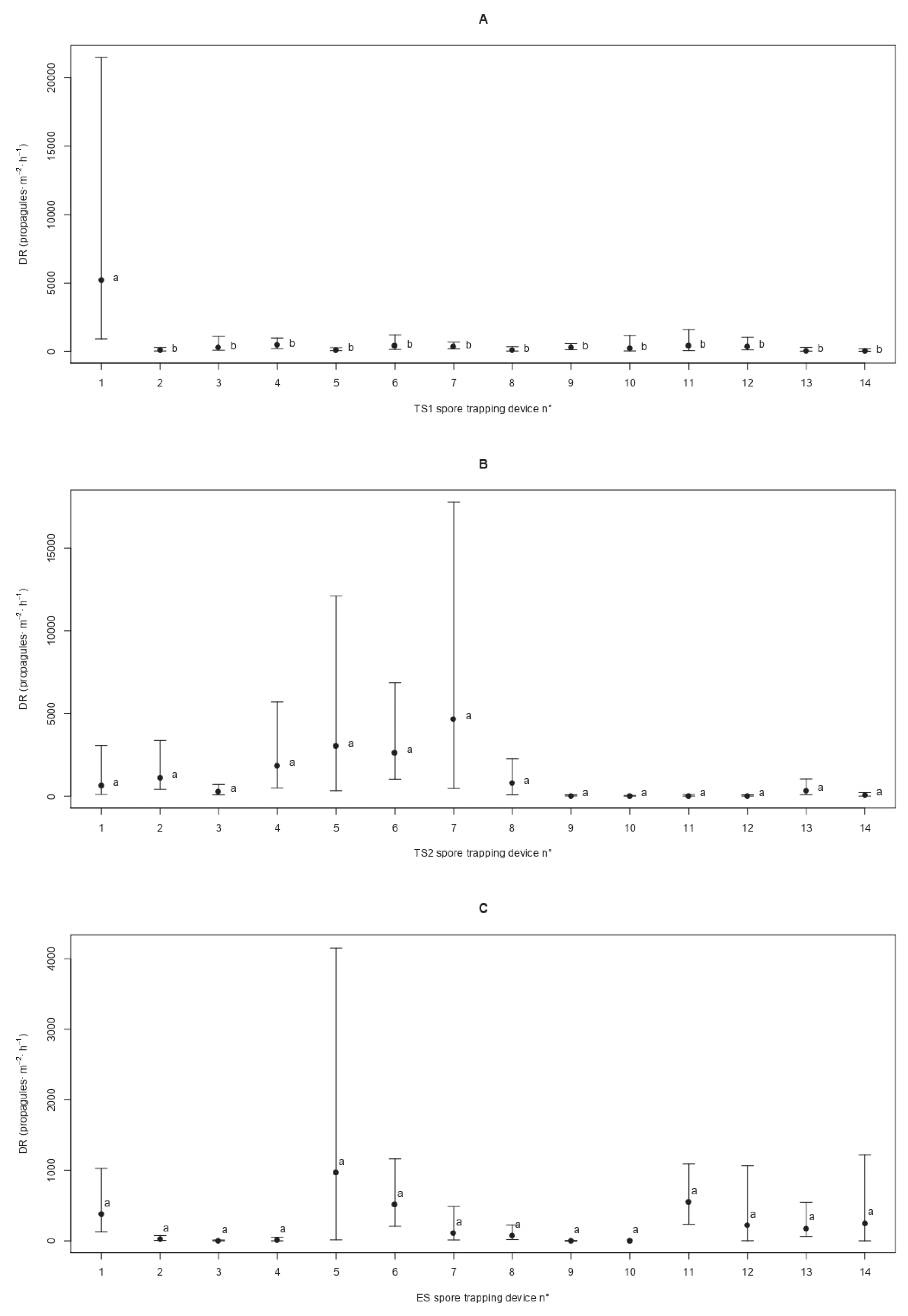Effects of Seasonality and Climate on the Propagule Deposition Patterns of the Chestnut Blight Pathogen Cryphonectria parasitica in Orchards of the Alpine District of North Western Italy
Abstract
:1. Introduction
2. Materials and Methods
2.1. Study Sites
2.2. Spore Trapping Experiment
2.3. Assessment of the Analytical Specificity and Sensitivity of the qPCR Assay
2.4. Spore Traps Processing and Propagule Deposition Quantification
2.5. Collection and Pre-Processing of Variables
2.6. Statistical Analyses and Modelling
3. Results
3.1. Performance of the qPCR Assay
3.2. Temporal Patterns of the Propagule Deposition of C. parasitica
3.3. Temporal Variables Related to the Propagule Deposition of C. parasitica
3.4. Climatic Variables Associated with the Propagule Deposition of C. parasitica
3.5. Spatial Patterns of the Propagule Deposition of C. parasitica
4. Discussion
5. Conclusions
Supplementary Materials
Author Contributions
Funding
Institutional Review Board Statement
Informed Consent Statement
Data Availability Statement
Acknowledgments
Conflicts of Interest
References
- Bounous, G.; Torello Marinoni, D. Chestnut: Botany, horticulture, and utilization. Hortic. Rev. 2005, 31, 291–347. [Google Scholar] [CrossRef]
- Bounous, G.; Beccaro, G. History: Growing and using the chestnut in the world from past to present. In The Chestnut Handbook—Crop and Forest Management; Beccaro, G., Alma, A., Bounous, G., Gomes-Laranjo, J., Eds.; CRC Press: Boca Raton, FL, USA, 2020; pp. 1–4. [Google Scholar]
- Conedera, M.; Manetti, M.C.; Giudici, F.; Amorini, E. Distribution and economic potential of the Sweet chestnut (Castanea sativa Mill.) in Europe. Ecol. Mediterr. 2004, 30, 179–193. [Google Scholar] [CrossRef]
- Gobbin, D.; Hohl, L.; Conza, L.; Jermini, M.; Gessler, C.; Conedera, M. Microsatellite-based characterization of the Castanea sativa cultivar heritage of southern Switzerland. Genome 2007, 50, 1089–1103. [Google Scholar] [CrossRef] [PubMed] [Green Version]
- De Vasconcelos, M.C.; Bennett, R.N.; Rosa, E.A.; Ferreira-Cardoso, J.V. Composition of European chestnut (Castanea sativa Mill.) and association with health effects: Fresh and processed products. J. Sci. Food Agric. 2010, 90, 1578–1589. [Google Scholar] [CrossRef] [PubMed]
- Piccolo, E.L.; Landi, M.; Ceccanti, C.; Mininni, A.N.; Marchetti, L.; Massai, R.; Guidi, L.; Remorini, D. Nutritional and nutraceutical properties of raw and traditionally obtained flour from chestnut fruit grown in Tuscany. Eur. Food Res. Technol. 2020, 246, 1867–1876. [Google Scholar] [CrossRef]
- De Biaggi, M.; Beccaro, G.; Casey, J.; Riqué, P.H.; Conedera, M.; Gomes-Laranjo, J.; Fulbright, D.W.; Nishio, S.; Serdar, U.; Zou, F.; et al. Distribution, Marketing, and Trade. In The Chestnut Handbook—Crop and Forest Management; Beccaro, G., Alma, A., Bounous, G., Gomes-Laranjo, J., Eds.; CRC Press: Boca Raton, FL, USA, 2020; pp. 35–52. [Google Scholar]
- Beccaro, G.L.; Donno, D.; Lione, G.G.; De Biaggi, M.; Gamba, G.; Rapalino, S.; Riondato, I.; Gonthier, P.; Mellano, M.G. Castanea spp. agrobiodiversity conservation: Genotype influence on chemical and sensorial traits of cultivars grown on the same clonal rootstock. Foods 2020, 9, 1062. [Google Scholar] [CrossRef]
- Anagnostakis, S.L. Chestnut breeding in the United States for disease and insect resistance. Plant. Dis. 2012, 96, 1392–1403. [Google Scholar] [CrossRef]
- Mellano, M.G.; Beccaro, G.L.; Donno, D.; Marinoni, D.T.; Boccacci, P.; Canterino, S.; Cerutti, A.K.; Bounous, G. Castanea spp. biodiversity conservation: Collection and characterization of the genetic diversity of an endangered species. Genet. Resour. Crop. Evol. 2012, 59, 1727–1741. [Google Scholar] [CrossRef]
- Beccaro, G.L.; Alma, A.; Gonthier, P.; Mellano, M.G.; Ferracini, C.; Giordano, L.; Lione, G.; Donno, D.; Boni, I.; Ebone, A.; et al. Chestnut R&D Centre, Piemonte (Italy): 10 years of activity. Acta Hortic. 2018, 1220, 133–140. [Google Scholar] [CrossRef]
- Lione, G.; Danti, R.; Fernandez-Conradi, P.; Ferreira-Cardoso, J.V.; Lefort, F.; Marques, G.; Meyer, J.B.; Prospero, S.; Radócz, L.; Robin, C.; et al. The emerging pathogen of chestnut Gnomoniopsis castaneae: The challenge posed by a versatile fungus. Eur. J. Plant Pathol. 2019, 153, 671–685. [Google Scholar] [CrossRef]
- Gonthier, P.; Robin, C. Diseases. In The Chestnut Handbook—Crop and Forest Management; Beccaro, G., Alma, A., Bounous, G., Gomes-Laranjo, J., Eds.; CRC Press: Boca Raton, FL, USA, 2020; pp. 297–315. [Google Scholar]
- Rigling, D.; Prospero, S. Cryphonectria parasitica, the causal agent of chestnut blight: Invasion history, population biology and disease control. Mol. Plant Pathol. 2018, 19, 7–20. [Google Scholar] [CrossRef] [PubMed] [Green Version]
- Lione, G.; Giordano, L.; Turina, M.; Gonthier, P. Hail-induced infections of the chestnut blight pathogen Cryphonectria parasitica depend on wound size and may lead to severe diebacks. Phytopathology 2020, 110, 1280–1293. [Google Scholar] [CrossRef] [PubMed]
- Milgroom, M.G.; Cortesi, P. Analysis of population structure of the chestnut blight fungus based on vegetative incompatibility genotypes. Proc. Natl. Acad. Sci. USA 1999, 96, 10518–10523. [Google Scholar] [CrossRef] [PubMed] [Green Version]
- Robin, C.; Anziani, C.; Cortesi, P. Relationship between biological control, incidence of hypovirulence, and diversity of vegetative compatibility types of Cryphonectria parasitica in France. Phytopathology 2000, 90, 730–737. [Google Scholar] [CrossRef] [PubMed] [Green Version]
- Double, M.L.; Jarosz, A.M.; Fulbright, D.W.; Davelos Baines, A.; MacDonald, W.L. Evaluation of two decades of Cryphonectria parasitica hypovirus introduction in an American chestnut stand in Wisconsin. Phytopathology 2018, 108, 702–710. [Google Scholar] [CrossRef] [Green Version]
- Garbelotto, M.; Frigimelica, G.; Mutto-Accordi, S. Vegetative compatibility and conversion to hypovirulence among isolates of Cryphonectria parasitica from Northern Italy. Forest Pathol. 1992, 22, 337–348. [Google Scholar] [CrossRef]
- Melzer, M.S.; Dunn, M.; Zhou, T.; Boland, G.J. Assessment of hypovirulent isolates of Cryphonectria parasitica for potential in biological control of chestnut blight. Can. J. Plant Pathol. 1997, 19, 69–77. [Google Scholar] [CrossRef]
- Prospero, S.; Conedera, M.; Heiniger, U.; Rigling, D. Saprophytic activity and sporulation of Cryphonectria parasitica on dead chestnut wood in forests with naturally established hypovirulence. Phytopathology 2006, 96, 1337–1344. [Google Scholar] [CrossRef] [Green Version]
- Beccaro, G.; Bounous, G.; Cuenca, B.; Bounous, M.; Warmund, M.; Xiong, H.; Zhang, L.; Zou, F.; Serdar, U.; Akyuz, B.; et al. Nursery Techniques. In The Chestnut Handbook—Crop and Forest Management; Beccaro, G., Alma, A., Bounous, G., Gomes-Laranjo, J., Eds.; CRC Press: Boca Raton, FL, USA, 2020; pp. 119–154. [Google Scholar]
- Beccaro, G.; Bounous, G.; Gomes-Laranjo, J.; Warmund, M.; Casey, J. Orchard management. In The Chestnut Handbook—Crop and Forest Management; Beccaro, G., Alma, A., Bounous, G., Gomes-Laranjo, J., Eds.; CRC Press: Boca Raton, FL, USA, 2020; pp. 155–182. [Google Scholar]
- Gonthier, P.; Garbelotto, M.; Nicolotti, G. Seasonal patterns of spore deposition of Heterobasidion species in four forests of the western Alps. Phytopathology 2005, 95, 759–767. [Google Scholar] [CrossRef] [Green Version]
- Simberloff, D. The role of propagule pressure in biological invasions. Annu. Rev. Ecol. Evol. Syst. 2009, 40, 81–102. [Google Scholar] [CrossRef]
- Lione, G.; Gonthier, P. A permutation-randomization approach to test the spatial distribution of plant diseases. Phytopathology 2016, 106, 19–28. [Google Scholar] [CrossRef] [PubMed] [Green Version]
- Lione, G.; Giordano, L.; Sillo, F.; Brescia, F.; Gonthier, P. Temporal and spatial propagule deposition patterns of the emerging fungal pathogen of chestnut Gnomoniopsis castaneae in orchards of north-western Italy. Plant Pathol. 2021, 70, 2016–2033. [Google Scholar] [CrossRef]
- Levetin, E. Aerobiology of agricultural pathogens. In Manual of Environmental Microbiology, 4th ed.; Yates, M.V., Nakatsu, C.H., Miller, R.V., Pillai, S.D., Eds.; ASM Press: Washington, DC, USA, 2016. [Google Scholar] [CrossRef]
- Guerin, L.; Froidefond, G.; Xu, X.M. Seasonal patterns of dispersal of ascospores of Cryphonectria parasitica (chestnut blight). Plant Pathol. 2001, 50, 717–724. [Google Scholar] [CrossRef]
- Lione, G.; Giordano, L.; Sillo, F.; Gonthier, P. Testing and modelling the effects of climate on the incidence of the emergent nut rot agent of chestnut Gnomoniopsis castanea. Plant Pathol. 2015, 64, 852–863. [Google Scholar] [CrossRef]
- Nosenzo, A. Determinazione degli assortimenti ritraibili dai boschi cedui di castagno: L’Esempio della bassa Valle di Susa (Torino). Forest 2007, 4, 118–125. [Google Scholar] [CrossRef]
- Garbelotto, M.; Smith, T.; Schweigkofler, W. Variation in rates of spore deposition of Fusarium circinatum, the causal agent of pine pitch canker, over a 12-month-period at two locations in Northern California. Phytopathology 2008, 98, 137–143. [Google Scholar] [CrossRef] [PubMed] [Green Version]
- Grosdidier, M.; Aguayo, J.; Marçais, B.; Ioos, R. Detection of plant pathogens using Real-Time PCR: How reliable are late Ct values? Plant Pathol. 2017, 66, 359–367. [Google Scholar] [CrossRef]
- Chandelier, A.; Massot, M.; Fabreguettes, O.; Gischer, F.; Teng, F.; Robin, C. Early detection of Cryphonectria parasitica by Real-Time PCR. Eur. J. Plant Pathol. 2019, 153, 29–46. [Google Scholar] [CrossRef]
- Desimoni, E.; Brunetti, B. About estimating the limit of detection by the signal to noise approach. Pharm. Anal. Acta 2015, 6, 1–4. [Google Scholar] [CrossRef]
- White, T.J.; Bruns, T.; Lee, S.; Taylor, J. Amplification and direct sequencing of fungal ribosomal RNA genes for phylogenetics. In PCR Protocols. A Guide to Methods and Applications; Innis, M.A., Gelfand, D.H., Sninsky, J.J., Eds.; Academic Press: San Diego, CA, USA, 1990; pp. 315–322. [Google Scholar]
- ARPA Piemonte. Banca Dati Meteorologica e Idrologica. 2020. Available online: http://www.arpa.piemonte.it (accessed on 15 October 2020).
- Garbelotto, M.; Schmidt, D.; Swain, S.; Hayden, K.; Lione, G. The ecology of infection between a transmissive and a dead-end host provides clues for the treatment of a plant disease. Ecosphere 2017, 8, e01815. [Google Scholar] [CrossRef] [Green Version]
- DiCiccio, T.J.; Efron, B. Bootstrap confidence intervals. Stat. Sci. 1996, 11, 189–228. [Google Scholar] [CrossRef]
- Wickham, H. A layered grammar of graphics. J. Comput. Graph. Stat. 2010, 19, 3–28. [Google Scholar] [CrossRef]
- Hothorn, T.; Hornik, K.; Zeileis, A. Unbiased recursive partitioning: A conditional inference framework. J. Comput. Graph. Stat. 2006, 15, 651–674. [Google Scholar] [CrossRef] [Green Version]
- Hothorn, T.; Zeileis, A. partykit: A modular toolkit for recursive partytioning in R. J. Mach. Learn. Res. 2015, 16, 3905–3909. [Google Scholar]
- Zeileis, A.; Leisch, F.; Hornik, K.; Kleiber, C. strucchange: An R package for testing for structural change in linear regression models. J. Stat. Soft. 2002, 7, 1–38. [Google Scholar] [CrossRef] [Green Version]
- Pewsey, A.; Neuhäuser, M.; Ruxton, G.D. Circular Statistics in R; Oxford University Press: Oxford, UK, 2013. [Google Scholar]
- Crawley, M.J. The R Book, 2nd ed.; John Wiley & Sons: Chichester, UK, 2013. [Google Scholar]
- Royston, P. A pocket-calculator algorithm for the Shapiro-Francia test for non-normality: An application to medicine. Statist. Med. 1993, 12, 181–184. [Google Scholar] [CrossRef] [PubMed]
- Wagenmakers, E.J.; Farrell, S. AIC model selection using Akaike weights. Bull. Psychon. Soc. 2004, 11, 192–196. [Google Scholar] [CrossRef] [PubMed]
- Ramsey, J.B. Tests for specification errors in classical linear least squares regression analysis. J. R. Stat. Soc. Ser. B Stat. Methodol. 1969, 31, 350–371. [Google Scholar] [CrossRef]
- Piñeiro, G.; Perelman, S.; Guerschman, J.P.; Paruelo, J.M. How to evaluate models: Observed vs. predicted or predicted vs. observed? Ecol. Modell. 2008, 216, 316–322. [Google Scholar] [CrossRef]
- Bliemel, F. Theil’s forecast accuracy coefficient: A clarification. J. Mark. Res. 1973, 10, 444–446. [Google Scholar] [CrossRef]
- Anselin, L. Local indicators of spatial association—LISA. Geogr. Anal. 1995, 27, 93–115. [Google Scholar] [CrossRef]
- Hui, W.; Gel, Y.R.; Gastwirth, J.L. Lawstat: An R package for law, public policy and biostatistics. J. Stat. Soft. 2008, 28, 1–26. [Google Scholar] [CrossRef] [Green Version]
- R Core Team. R: A Language and Environment for Statistical Computing; R Foundation for Statistical Computing: Vienna, Austria, 2019; Available online: https://www.R-project.org/ (accessed on 27 October 2019).
- Efron, B.; Tibshirani, R.J. An Introduction to the Bootstrap; Chapman & Hall/CRC: Boca Raton, FL, USA, 1994. [Google Scholar]
- Signorell, A.; Aho, K.; Alfons, A.; Anderegg, N.; Aragon, T.; Arppe, A. DescTools: Tools for Descriptive Statistics. R Package Version 0.99, 18. 2016. Available online: https://cran.r-project.org/web/packages/DescTools/index.html (accessed on 15 February 2022).
- Greenwell, B.M.; Kabban, C.M. Investr: An R package for inverse estimation. R J. 2014, 6, 90–100. [Google Scholar] [CrossRef] [Green Version]
- Kalogirou, S. lctools: Local Correlation, Spatial Inequalities, Geographically Weighted Regression and Other Tools. R Package Version 0.2-8. 2020. Available online: https://CRAN.R-project.org/package=lctools (accessed on 15 February 2022).
- Zeileis, A.; Hothorn, T. Diagnostic checking in regression relationships. R News 2002, 2, 7–10. [Google Scholar]
- Hamner, B.; Frasco, M. Metrics: Evaluation Metrics for Machine Learning. R Package Version 0.1.4. 2018. Available online: https://CRAN.R-project.org/package=Metrics (accessed on 15 February 2022).
- Barton, K. MuMIn: Multi-Model Inference. R Package Version 1.43.6. 2019. Available online: https://cran.r-project.org/web/packages/MuMIn/index.html (accessed on 15 February 2022).
- Baddeley, A.; Turner, R. spatstat: An R Package for analyzing spatial point patterns. J. Stat. Soft. 2005, 12, 1–42. [Google Scholar] [CrossRef] [Green Version]
- Langrell, S.R.H. Development of a nested PCR detection procedure for Nectria fuckeliana direct from Norway spruce bark extracts. FEMS Microbiol. Lett. 2005, 242, 185–193. [Google Scholar] [CrossRef] [Green Version]
- Prospero, S.; Rigling, D. Chestnut blight. In Infectious Forest Diseases; Gonthier, P., Nicolotti, P., Eds.; CAB International: Wallingford, UK, 2013; pp. 318–339. [Google Scholar]
- Calvo-Garrido, C.; Teixidó, N.; Roudet, J.; Viñas, I.; Usall, J.; Fermaud, M. Biological control of Botrytis bunch rot in Atlantic climate vineyards with Candida sake CPA-1 and its survival under limiting conditions of temperature and humidity. Biol. Control 2014, 79, 24–35. [Google Scholar] [CrossRef]
- Raible, C.C.; Casty, C.; Luterbacher, J.; Pauling, A.; Esper, J.; Frank, D.C.; Büntgen, U.; Roesch, A.C.; Tschuck, P.; Wild, M.; et al. Climate variability—Observations, reconstructions, and model simulations for the Atlantic-European and Alpine region from 1500-2100 AD. Clim. Chang. 2006, 79, 9–29. [Google Scholar] [CrossRef]
- Li, D.W.; Kendrick, B. A year-round study on functional relationships of airborne fungi with meteorological factors. Int. J. Biometeorol. 1995, 39, 74–80. [Google Scholar] [CrossRef]
- Peay, K.G.; Bruns, T.D. Spore dispersal of basidiomycete fungi at the landscape scale is driven by stochastic and deterministic processes and generates variability in plant–fungal interactions. New Phytol. 2014, 204, 180–191. [Google Scholar] [CrossRef]
- Schiro, G.; Verch, G.; Grimm, V.; Müller, M. Alternaria and Fusarium fungi: Differences in distribution and spore deposition in a topographically heterogeneous wheat field. J. Fungi 2018, 4, 63. [Google Scholar] [CrossRef] [PubMed] [Green Version]
- Mitchell, A. The ESRI Guide to GIS Analysis, Volume 2: Spatial Measurements and Statistics; ESRI Press: Redlands, CA, USA, 2009. [Google Scholar]
- Reaser, J.K.; Meyerson, L.A.; Von Holle, B. Saving camels from straws: How propagule pressure-based prevention policies can reduce the risk of biological invasion. Biol. Invasions 2008, 10, 1085–1098. [Google Scholar] [CrossRef] [Green Version]
- Kenaley, S.C.; Double, M.L.; MacDonald, W.L. Effect of Spore Concentration on the Establishment of Cytoplasmic Hypovirulent (HV), Transgenic HV, and Virulent Isolates of Cryphonectria parasitica, the Chestnut Blight Fungus. In Proceedings of the Fifth International Chestnut Symposium (Acta Horticulturae), 4–8 September 2012; Double, M.L., MacDonald, W.L., Eds.; ISHS: Korbeek-Lo, Belgium, 2014; pp. 165–171. [Google Scholar] [CrossRef]
- Bazzigher, G. Selection of blight-resistant chestnut trees in Switzerland. Eur. J. For. Pathol. 1981, 11, 199–207. [Google Scholar] [CrossRef]
- Guerin, L.; Robin, C. Seasonal effect on infection and development of lesions caused by Cryphonectria parasitica in Castanea sativa. For. Pathol. 2003, 33, 223–235. [Google Scholar] [CrossRef]
- Heald, F.D.; Gardner, M.W.; Studhalter, R.A. Air and wind dissemination of ascospores of chestnut-blight fungus. J. Agric. Res. 1915, 3, 493–526. [Google Scholar]
- Rankin, W.H. Field studies on Endothia canker of chestnut in New York State. Phytopathology 1914, 4, 233–261. [Google Scholar]
- Kendrick, B. The Fifth Kingdom; Focus Publishing: Newburyport, MA, USA, 2017. [Google Scholar]
- Anderson, P.J. Wind dissemination of the chestnut blight organism. Phytopathology 1913, 3, 1–44. [Google Scholar]
- Anagnostakis, S.L.; Aylor, D.E. The effect of temperature on growth of Endothia (Cryphonectria) parasitica in vitro and in vivo. Mycologia 1984, 76, 387–397. [Google Scholar] [CrossRef]
- Bastiancich, L.; Lasagna, M.; Mancini, S.; Falco, M.; De Luca, D.A. Temperature and discharge variations in natural mineral water springs due to climate variability: A case study in the Piedmont Alps (NW Italy). Environ. Geochem. Health 2021. [Google Scholar] [CrossRef]
- Farooq, A.; Sanja, B. Genetic diversity of Cryphonectria parasitica causing chestnut blight in South Tyrol (northern Italy). Eur. J. Plant Pathol. 2022, 162, 621–635. [Google Scholar] [CrossRef]
- Prospero, S.; Rigling, D. Invasion genetics of the chestnut blight fungus Cryphonectria parasitica in Switzerland. Phytopathology 2012, 102, 73–82. [Google Scholar] [CrossRef] [PubMed] [Green Version]





| Timeframe | ||||
|---|---|---|---|---|
| Climatic Variable | i = 7 | i = 14 | i = 21 | i = 30 |
| GDD0i | c = 0.064 p = 0.998 | c = 0.001 p = 0.999 | c = 0.003 p = 0.999 | c = 0.072 p = 0.997 |
| GDD5i | c = 0.009 p = 0.999 | c = 0.039 p = 0.999 | c = 0.045 p = 0.999 | c = 0.130 p = 0.993 |
| Psumi | c = 3.056 p = 0.284 | c = 0.003 p = 0.999 | c = 0.412 p = 0.947 | c = 0.165 p = 0.990 |
| Pmeani | c = 3.056 p = 0.284 | c = 0.011 p = 0.999 | c = 0.446 p = 0.939 | c = 0.173 p = 0.989 |
| NDP0i | c = 5.370 p = 0.079 | c = 3.681 p = 0.202 | c = 0.799 p = 0.843 | c = 3.096 p = 0.278 |
| NDP1i | c = 7.335 * p = 0.027 | c = 0.570 p = 0.908 | c = 0.047 p = 0.999 | c = 0.943 p = 0.800 |
| NDP2i | c = 7.418 * p = 0.026 | c = 0.788 p = 0.755 | c = 0.674 p = 0.796 | c = 2.796 p = 0.257 |
| NDP5i | c = 8.760 * p = 0.012 | c = 0.813 p = 0.746 | c = 0.387 p = 0.898 | c = 2.036 p = 0.393 |
| NDP10i | c = 4.027 p = 0.167 | c = 0.030 p = 0.999 | c = 0.001 p = 0.999 | c = 0.001 p = 0.999 |
| NDP15i | c = 2.466 p = 0.390 | c = 0.146 p = 0.992 | c = 0.188 p = 0.987 | c = 0.205 p = 0.984 |
| NDP20i | c = 0.012 p = 0.999 | c = 1.892 p = 0.522 | c = 1.451 p = 0.645 | c = 1.380 p = 0.666 |
| NDP25i | c = 0.084 p = 0.997 | c = 2.567 p = 0.369 | c = 2.082 p = 0.475 | c = 2.301 p = 0.425 |
| NDP30i | c = 0.197 p = 0.986 | c = 1.975 p = 0.501 | c = 2.118 p = 0.466 | c = 2.492 p = 0.384 |
| Tmeani | c = 0.065 p = 0.998 | c = 0.010 p = 0.999 | c = 0.007 p = 0.999 | c = 0.081 p = 0.997 |
| Tmaxi | c = 0.162 p = 0.990 | c = 0.377 p = 0.954 | c = 0.185 p = 0.987 | c = 0.319 p = 0.966 |
| Tmini | c = 0.237 p = 0.980 | c = 0.003 p = 0.999 | c = 0.001 p = 0.999 | c = 0.050 p = 0.999 |
| RHmeani | c = 1.446 p = 0.646 | c = 0.311 p = 0.967 | c = 0.020 p = 0.999 | c = 0.031 p = 0.999 |
| RHmaxi | c = 0.628 p = 0.892 | c = 0.336 p = 0.963 | c = 0.058 p = 0.998 | c = 0.030 p = 0.999 |
| RHmini | c = 5.328 p = 0.081 | c = 3.040 p = 0.287 | c = 1.499 p = 0.631 | c = 0.692 p = 0.875 |
| WSi | c = 0.781 p = 0.849 | c = 0.551 p = 0.913 | c = 0.765 p = 0.853 | c = 0.404 p = 0.949 |
| WGi | c = 0.619 p = 0.895 | c = 0.581 p = 0.905 | c = 0.804 p = 0.842 | c = 0.665 p = 0.882 |
| TCWi | c = 0.018 p = 0.999 | c = 0.059 p = 0.998 | c = 0.031 p = 0.999 | c = 0.571 p = 0.908 |
| x | RT | m | q | FT | SFT | m′ | q′ | R2 | AICc | AICcw | UII | me′ | qe′ | RMSEP | UIIe |
|---|---|---|---|---|---|---|---|---|---|---|---|---|---|---|---|
| - | - | - | 0.464 * (1.00 × 10−16) | - | - | - | - | - | 42.200 | 0.013 | - | - | - | - | |
| NDP17 | 1.840 (0.167) | 0.069 * (5.88 × 10−3) | 0.349 * (1.52 × 10−8) | 8.090 * (5.87 × 10−3) | 0.981 (0.316) | 1.000 (1.000) | 1.62 × 10−15 (1.000) | 0.106 | 36.543 | 0.229 | 0.533 | 1.232 (0.604) | −0.111 (0.606) | 0.253 | 0.463 |
| NDP27 | 1.547 (0.220) | 0.076 * (5.59 × 10−3) | 0.358 * (2.40 × 10−9) | 8.191 * (5.59 × 10−3) | 0.985 (0.516) | 1.000 (1.000) | 1.64 × 10−15 (1.000) | 0.107 | 36.450 | 0.240 | 0.533 | 1.278 (0.573) | −0.141 (0.555) | 0.257 | 0.470 |
| NDP57 | 2.188 (0.120) | 0.100 * (2.47 × 10−3) | 0.366 * (7.77 × 10−11) | 9.888 * (2.46 × 10−3) | 0.985 (0.494) | 1.000 (1.000) | 2.65 × 10−16 (1.000) | 0.127 | 34.908 | 0.518 | 0.527 | 1.069 (0.887) | −0.038 (0.873) | 0.265 | 0.484 |
Publisher’s Note: MDPI stays neutral with regard to jurisdictional claims in published maps and institutional affiliations. |
© 2022 by the authors. Licensee MDPI, Basel, Switzerland. This article is an open access article distributed under the terms and conditions of the Creative Commons Attribution (CC BY) license (https://creativecommons.org/licenses/by/4.0/).
Share and Cite
Lione, G.; Brescia, F.; Giordano, L.; Gonthier, P. Effects of Seasonality and Climate on the Propagule Deposition Patterns of the Chestnut Blight Pathogen Cryphonectria parasitica in Orchards of the Alpine District of North Western Italy. Agriculture 2022, 12, 644. https://doi.org/10.3390/agriculture12050644
Lione G, Brescia F, Giordano L, Gonthier P. Effects of Seasonality and Climate on the Propagule Deposition Patterns of the Chestnut Blight Pathogen Cryphonectria parasitica in Orchards of the Alpine District of North Western Italy. Agriculture. 2022; 12(5):644. https://doi.org/10.3390/agriculture12050644
Chicago/Turabian StyleLione, Guglielmo, Francesca Brescia, Luana Giordano, and Paolo Gonthier. 2022. "Effects of Seasonality and Climate on the Propagule Deposition Patterns of the Chestnut Blight Pathogen Cryphonectria parasitica in Orchards of the Alpine District of North Western Italy" Agriculture 12, no. 5: 644. https://doi.org/10.3390/agriculture12050644
APA StyleLione, G., Brescia, F., Giordano, L., & Gonthier, P. (2022). Effects of Seasonality and Climate on the Propagule Deposition Patterns of the Chestnut Blight Pathogen Cryphonectria parasitica in Orchards of the Alpine District of North Western Italy. Agriculture, 12(5), 644. https://doi.org/10.3390/agriculture12050644







